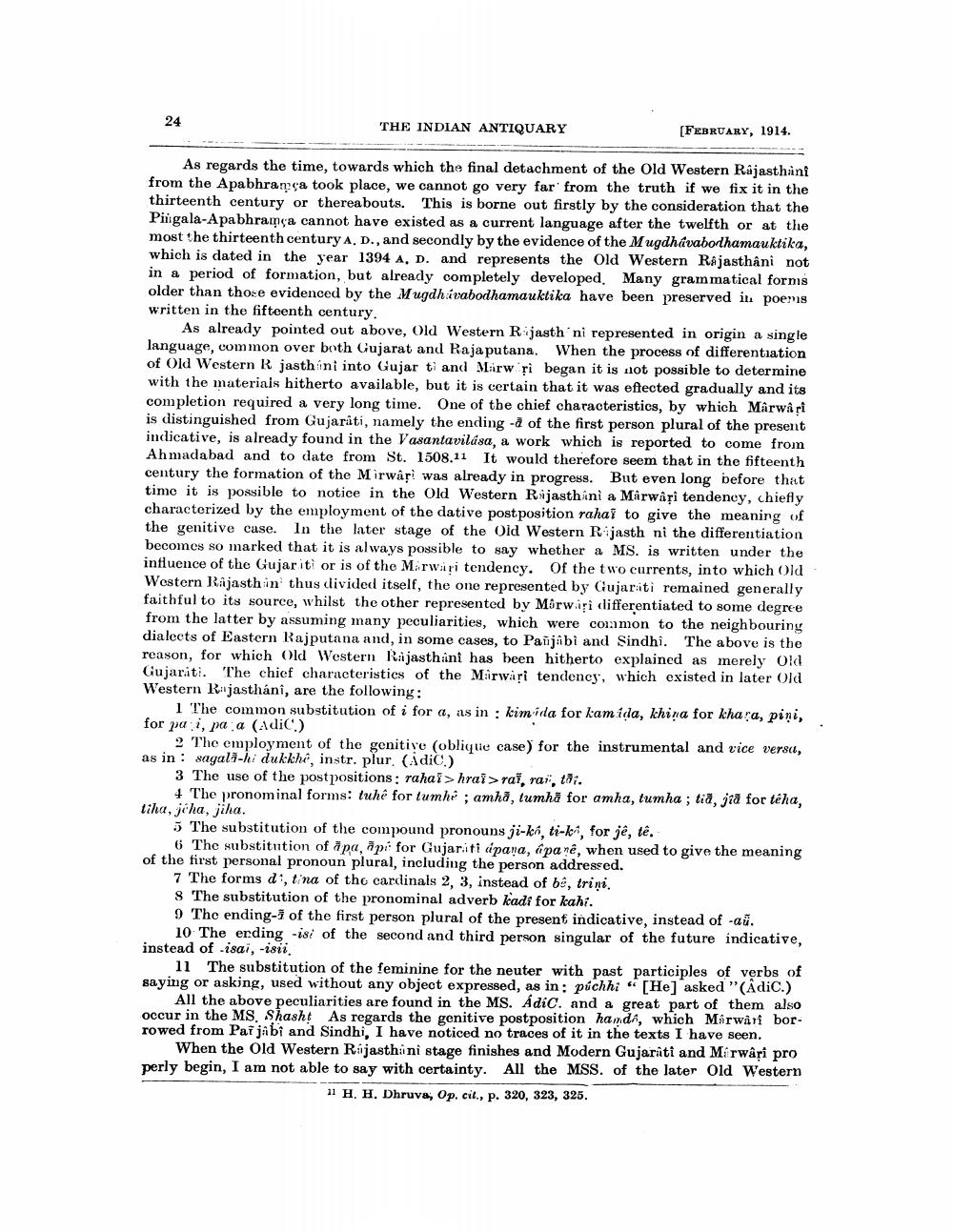________________
24
THE INDIAN ANTIQUARY
(FEBRUARY, 1914.
As regards the time, towards which the final detachment of the Old Western Rajasthani from the Apabhrança took place, we cannot go very far from the truth if we fix it in the thirteenth century or thereabouts. This is borne out firstly by the consideration that the Pingala-Apabhramça cannot have existed as a current language after the twelfth or at the most the thirteenth century A.D., and secondly by the evidence of the Mugdhavaborlhamauktika, which is dated in the year 1394 A. D. and represents the Old Western Rajasthani not in a period of formation, but already completely developed. Many grammatical forms older than those evidenced by the Mugdhávabodhamauktika have been preserved it. poems written in the fifteenth century.
As already pointed out above, Old Western Rijasth ni represented in origin a single language, common over both Gujarat and Rajaputana. When the process of differentiation of Old Western R jasth ini into Gujar ti and Marw pi began it is not possible to determine with the materiais hitherto available, but it is certain that it was eftected gradually and its completion required a very long time. One of the chief characteristics, by which Marwari is distinguished from Gujarati, namely the ending -d of the first person plural of the present indicative, is already found in the Vasantavilúsa, a work which is reported to come from Ahmadabad and to date from St. 1508.11 It would therefore seem that in the fifteenth century the formation of the Mirwapi was already in progress. But even long before that time it is possible to notice in the Old Western Rajasthani a Marwâți tendency, chiefly characterized by the employment of the dative postposition rahas to give the meaning of the genitive case. In the later stage of the Old Western Rijasth ni the differentiation becomes so marked that it is always possible to say whether a MS. is written under the influence of the Gujarit or is of the Marwari tendency. Of the two currents, into which Old Western Rajasthin thus divided itself, the one represented by Gujarati remained generally faithful to its source, whilst the other represented by Mórwisi «lifferentiated to some degree from the latter by assuming many peculiarities, which were conamon to the neighbouring dialects of Eastern Rajputana and, in some cases, to Panjabi and Sindhi. The above is the reason, for which Old Western Rajasthani has been hitherto explained as merely Old Gujarati. The chief characteristics of the Mirwari tendency, which existed in later Old Western Rajasthani, are the following:
1 The common substitution of i for a, as in : kimida for kam ida, khina for khara, pini, for pai, paa (dic.)
2 The employment of the genitive (obliqtie case) for the instrumental and vice versat, as in: sagala-hi dukkhe, instr. plur. (Adic.)
3 The use of the postpositions : raha > hrai>rai, rax, tài.
4 The pronominal forms: tuhé for tumhi; amha, tumha for amha, tumha; tid, jia for teha, tiha, jeha, jiha.
5 The substitution of the compound pronouns ji-ka, ti-k, for jê, tê.
6 The substitution of pa, pi for Gujariti apana, i parë, when used to give the meaning of the first personal pronoun plural, including the person addressed.
7 The forms di, tina of the cardinals 2, 3, instead of b, trini. 8 The substitution of the pronominal adverb kadi for kahi. 9 The ending-i of the first person plural of the present indicative, instead of -au.
10 The erding -isi of the second and third person singular of the future indicative, instead of -isai, -isii.
11 The substitution of the feminine for the neuter with past participles of verbs of saying or asking, used without any object expressed, as in: píchhi "[He] asked "(AdiC.)
All the above peculiarities are found in the MS. Adic. and a great part of them also occur in the MS, Shasht As regards the genitive postposition hand/, which Marwari bor. rowed from Pai jabi and Sindhi, I have noticed no traces of it in the texts I have seen.
When the Old Western Rijasthini stage finishes and Modern Gujarati and Mirwâri pro perly begin, I am not able to say with certainty. All the MSS. of the later Old Western
11 H. H. Dhruva, Op. cit., p. 320, 323, 325.




